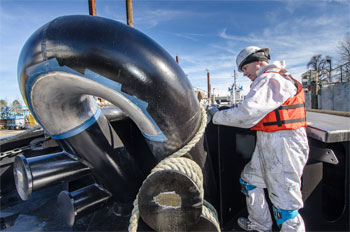These are not exactly boom times in the towing industry, but operators seem to have regained their footing and are finding reasons to build new boats. While some new business opportunities may be opening up, for most companies the most compelling reason for building new boats seems to be modernization of their aging fleets.
Many line-haul companies are thinking about expanding or modernizing their fleets, according to Jonathan Parrott, vice president of new design development at Jensen Maritime, the Seattle-based naval architecture and marine engineering firm.
Part of this trend has to do with the age of the current fleet.
In recent years the marine industry has seen the construction of a great many double-hull oil barges. But the tugs towing those modern barges tend to be older vessels, Parrott observed. That has left the oil majors and insurance companies to “question the wisdom” of towing a “five-year-old double-skin barge with a 50-year-old tugboat,” Parrott said.
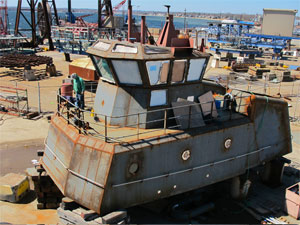 |
|
John Gormley |
|
The deckhouse of Eric McAllister at Senesco’s shipyard in Rhode Island. |
The expansion of the barge fleet means that it may not be enough for towing companies just to replace their aging ones with brand new vessels. As the size of the oil barge fleet expands, the tug fleet may have to follow suit.
“These new barges are not replacements,” Parrott said. “The line-haul tugs are a little behind the barges.” He suspects that a surge in new construction of line-haul tugs is in the offing. “The wave is coming,” he said.
That wave may already be taking shape. Hyak Maritime LLC built a 120-foot, line-haul vessel, Hawaii, in 2013 and a sister vessel, Washington, in 2014. Under charter to Crowley, both are 5,358-hp z-drive tugs. A third boat is under construction and a fourth is planned.
Hyak is a recent startup by Robert Dorn and a partner, Gordon LK Smith. They are in the business of building and then chartering their vessels rather than operating them themselves. Their strategy is based on the insight that many line-haul operators are depending on some of the oldest tugs in the country.
Dorn saw this at first-hand. In 2008 and 2009 he was in charge of the K-Sea Transportation fleet of 25 tugs and 25 barges. His annual budget for repair and maintenance was about $300,000 per tug. That kind of cost, he said, “makes it hard to make a case for operating old boats.”
Older boats are not even allowed to dock at some oil terminals. “At certain docks on the West Coast you can’t bring a tug over 25 years old,” he said. “There’s a new kind of paradigm. We could see it coming over the last 10 years.”
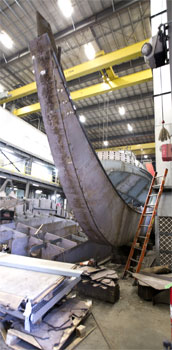 |
|
John Snyder |
|
The stem of a new tugboat taking shape at Washburn & Doughty in Maine. The yard is fully booked for the next few years. |
There are other forces at work leading to modernization of the line-haul fleets, notably the recognition of fleet operators that their boats need to be comfortable if they are to retain and attract good crews.
When many of the older boats that are still in service were built, crew comfort was not a driving concern of the owners. “They didn’t pay as much attention to vibration and noise,” Parrott said.
In the last 10 years, international standards have begun to reflect these concerns by calling for things such as minimum stateroom size, wash basins in rooms with no head and natural light in living quarters.
“There is a scarcity of good crews in the U.S. now,” Parrott said. “To attract good crews, you have to have good work conditions. Everyone’s taking a look at that.”
In addition to boats that will help them attract good crews, operators are also looking to upgrade with more powerful boats. Part of the push for more power is coming from the insurance companies and the pilots. “Everybody wants more power,” Parrott said. “It’s not whether you need more power. It’s the perceived idea that more power is better.”
And the days of the single-screw line-haul tug are over. “You’re not going to tow a barge with a boat with only a single-screw,” Parrott said.
If the era of the single-screw tug is past, the age of the LNG tug fueled by liquefied natural gas is still just over the horizon. Part of the problem is that tugs are relatively small vessels.
LNG vessels must have specially designed tanks for holding super-cold liquids. Typically they must be located above deck, and because LNG has less energy content per unit of volume, they must be larger than a conventional tank.
“You can’t stick it in the bilge,” Parrott said.
Another problem is the lack of LNG engines that would be appropriate for all but the largest tugs. No approved marinized dual-fuel engines smaller than 1,800 hp exist, Parrott said.
“All the major diesel engine makers are focused on Tier 4, getting that squared away,” said Parrott.
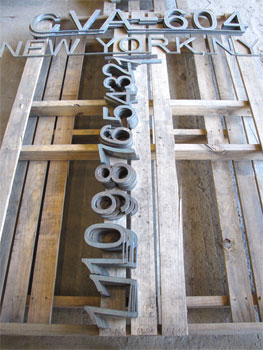 |
|
John Gormley |
|
Lettering and numbers for vessel names and draft indicators at Senesco. |
Bruce Washburn, executive vice president of Washburn & Doughty, a shipyard in East Boothbay, Maine, said that the coming Tier 4 requirements continue to have an impact on tug orders, as operators move to get their boats built before the Tier 4 requirements take effect. “This spurt we’ve seen accelerated by the upcoming emissions regs,” he said, noting that operators are “trying to get in ahead of them.”
His yard expects to deliver four tugs this year. “We’re fully booked for the next couple of years, booked or committed,” he said. “A lot of yards have gotten quite a backlog.”
He is optimistic that as the Tier 4 requirements come into effect, demand for new tugs will hold up. The opening of the new locks on the Panama Canal, now expected in late 2015, could help support demand for new tugs.
The new locks will permit much larger containerships to take the all-water route from the Far East via the canal to ports on the Gulf and East Coasts of the United States. That in turn will create demand for more powerful docking tugs.
The tugs being ordered are generally in the range of 5,000 to 6,000 hp. “That seems to be where everyone is targeting,” he said. At his yard, “everything under contract is 6,000 horsepower.”
The 6,000-hp standard may represent something of a ceiling for harbor tugs for a while.
“When you go above (6,000 hp), you step into the next level drive,” Washburn said, resulting in an increase in weight and price. These larger z-drives would require larger, more expensive tugs to accommodate them. “They’re not going in anything under 100 feet long,” Washburn said.
In the docking and escort sector, Moran Towing Corp. has one of the most ambitious building programs.
“We’ve got a lot going on,” said Moran President Ted Tregurtha. Moran expects to take delivery of two 93-foot ASD tugs this year from the Maine shipyard of Washburn & Doughty. Moran and W&D have an understanding that an additional 10 boats will be built at the Maine yard through 2018.
While that may sound like an expansion of the fleet, in fact Moran’s building strategy is primarily about replacing older vessels. “This is part of a long-term fleet replacement program and upgrading,” Tregurtha said.
Replacement accounts for “pretty much all of it,” he said. During the last 50 years, the company has maintained a fleet of about 100 tugs, building on average “two a year just to tread water.”
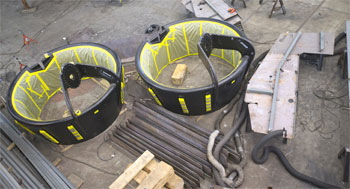 |
|
John Snyder |
|
Nozzles for a z-drive tug await attachment to a vessel at Washburn & Doughty, where Moran Towing has committed to building a dozen vessels through 2018. |
While there has been much discussion in the industry about the potential impact of the Panama Canal expansion, Moran is not banking on a surge in its business. “We’re not expecting huge changes in our vessel traffic as a result of the Panama Canal,” he said. “We’re not doing this (building new tugs) as a result of the Panama Canal.”
Moran may not have a larger fleet as a consequence of its building program, but it will have a more capable one. “Z-drives make for a more maneuverable, responsive tug,” Tregurtha said, creating a “greater margin of safety.”
Building new tugs also allows his company to operate vessels that are more comfortable for the crews and friendlier to the environment. “We are reinvesting in the fleet to service our existing customers in a way that is as safe as possible for the vessels, the crews and the environment,” he said. “Nothing is better than a brand-new vessel and technology for doing this.”
Brandon Durar, president of JonRie InterTech LLC, the winch maker based in Manahawkin, N.J., has perceived some slowing in the market. “Last year we were doing real good. All of a sudden things are getting flat again,” he said.
He noted many of the same factors that others say will promote construction of new tugs: the age of the tug fleets, rapid growth in the production of U.S. oil and gas, the need for fuel-efficient tugs that can compete with other new boats, the demands of customers for more powerful and reliable tugs.
“If your equipment is tired, they want new equipment out there,” he said. “There’s still a need for a lot more.”
And yet in recent months, from his vantage point, the marine economy has slowed. “Everybody’s sitting on the fence,” Durar said. “Everybody I talk to says they’re moving ahead…. We’re quoting up a storm,” but “orders are not being placed. Why, I don’t know.”
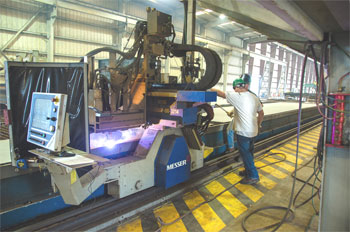 |
|
Brian Gauvin |
|
The welding machine in the panel building at Eastern Shipbuilding Group’s Allanton yard in Florida. Since 2006 Eastern has built 56 90-foot towboats for Florida Marine Transporters, in what has been called the largest single towboat construction contract in history. |
Internationally, the market for new tugboat construction seems to be much more vibrant than in North America. Robert Allan Ltd., the design firm based in Vancouver, British Columbia, reports having a very good year, with most of its designs being built for customers outside Canada and the United States. “For us it’s an unprecedented level of activity,” said Mike Fitzpatrick, the firm’s vice president projects. “This year I believe 60 tugs of our design will be delivered internationally. My main job now is picking what projects we take on.”
Even though the bulk of the firm’s work this year is for projects in South America, China, Australia and Europe, there is substantial potential close to home: ambitious plans for new terminals serving LNG carriers and crude oil tankers in Kitimat, British Columbia.
With these developments in mind, Robert Allan Ltd. is designing what would be the largest and most powerful escort tugs in the world, Fitzpatrick said. These boats would be over 160 feet long and have a bollard pull of 120 to 125 tons.
Kitimat is the proposed terminus for a pipeline, called the Northern Gateway, that would carry crude oil produced from the tar sands of Alberta to the coast of northern British Columbia.
There is substantial opposition to the project for environmental grounds. For example, in a non-binding vote held April 14, residents in the Kitimat area opposed the pipeline 58 percent to 48 percent.
Tankers transporting oil from Kitimat would have to transit Douglas Channel, a 56-mile-long fjord that is one-and-a-half to three miles wide. It passes through a pristine Northwest coastal area.
Robert Allan, the executive chairman of the design firm, said that if any of the LNG or crude oil projects proposed for Kitimat are developed, “that’s going to represent some pretty significant tug operations.”
The crude oil operation alone would mean ultimately 250 tankers per year, he said. “That’s where the escorting would be involved.”
Allan acknowledged that the waters that the ships and their escorts would have to transit would be challenging and the consequence of a spill in this biologically rich and sensitive area would be terrible.
“It’s a demanding environment,” he said. “It’s a pristine place. Nobody wants to see it destroyed.”
He believes tanker operations could be carried out safely in the Douglas Channel and connecting waterways. “The route is not hazardous,” he said, noting that the channel is deep and wide, with one S-bend.
“I feel pretty comfortable saying the risks are pretty low,” he said, adding, “You can never bring the risk to zero. How close to zero is good enough?”
If the Northern Gateway pipeline is approved, his firm hopes its design for the most powerful escort vessels in the world will be used. “If the project goes ahead, the design is ready,” Allan said.

